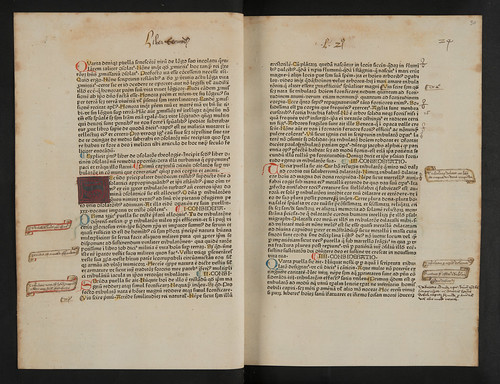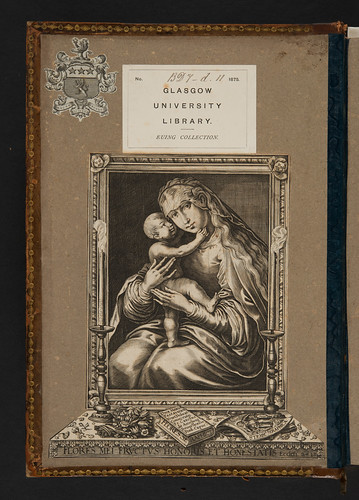Johannes de Tambaco: Consolatio theologiae. Complete text.
[Strassburg: Printer of Henricus Ariminensis (Georg Reyser?), ca. 1478]
Fol. [16 2-1410 158 16-3010]. [294] leaves.
ISTC ij00436000; GW M14759; Goff J436; BMC II 484 (IB. 943); Bod-inc J-200; CIBN J-288; BSB-Ink I-524.
Printed in type 4:88G of the editions ascribed by Kurt Ohly to Georg Reyser; BMC and Polain(B) 2316 assign this edition to [Speyer, Georgius de Spira]. Sack dates [ca. 1477]; Bod-inc dates [not after 1479].
The "complete text" (Vollständiger Text) - as identified in Carmen Cardelle de Hartmann 'Lateinische Dialoge 1200-1400. Literaturhistorische Studie und Repertorium' (Brill: 2007), pp. 623-624. (identified incorrectly as the short version in ISTC).
Two copies held by the University of Glasgow
Copy 1
| GIP number: | J26/1 |
| Shelf-mark: | Sp Coll Hunterian Bx.2.10 (see main library entry for this item) |
| Note: | Quire 1, the Tabula, misbound between quires 26 and 27. |
| Provenance: | Paris, Jesuits: inscription on 2/1r (f. 7r) “Collegij Paris. Soc. Jesu”; not found in Jesuit sale catalogues (Paris, 1763 and 1764). Louis Jean Gaignat (1697-1768), Secretary to King Louis XV: Gaignat sale, 1769; lot 271 in Guillaume de Bure, Bibliographie instructive: supplément ... ou catalogue des livres de feu M. L.J. Gaignat, 2 vols (Paris: 1769). NB according to the Bibliothèque Méjanes annotated copy (Res. O. 189) of the Gaignat sale catalogue, Gaignat bought the book for 60 livres. William Hunter (1718-1783), physician and anatomist: purchased by Hunter at the Gaignat sale through his agent, Jean-Baptiste Dessain, for 12 livres 1 sou; see Dessain-Hunter correspondence (University of Glasgow Library, MS Gen. 36, f. 25r). University of Glasgow: Hunterian bequest, 1807; Hunterian Museum bookplate on front pastedown, with former shelfmark “M.4.6”. |
| Binding: | France, 18th-century red goatskin; covers decorated with a triple gold-fillet border, a small gold fleuron at each corner; gold-tooled spine; marbled endpapers; gilt-edged leaves; turquoise silk bookmark. Size: 301 x 225 mm. |
| Leaf size: | 292 x 210 mm. |
| Annotations: | Occasional marginal annotations in a 15th/16th-century hand (some enclosed within scrolls); occasional nota marks and manicules; book numbers occasionally written in the upper margin e.g. “Liber septimus”; foliated with errors in a 16th-century hand, with occasional references to that foliation in the Tabula. |
| Decoration: | Six-line initial “Q” of the Prologus on 2/1r (f. 7r) supplied in gold on a blue square ground decorated with white tracery and edged in red, brown and gold; a seven-line initial “D” (in error for “C”) at the commencement of book I is supplied in blue with white tracery on a square crimson ground embellished with gold decoration, the body of the letter infilled with strawberries and blue flowers on a gold background; the opening initials of books II-XV are mainly supplied in silver (oxidized) on a crimson background; initials in red and blue with reserved white supplied at the beginning of each chapter; smaller initials and paragraph marks supplied throughout in alternate red and blue; capitals washed in yellow throughout. |
| Imperfections: | None. |
Copy 2
| GIP number: | J26/2 |
| Shelf-mark: | Sp Coll BD7-d.11 (see main library entry for this item) |
| Note: | 28/3 and 28/8 (ff. 267 and 272) are cancels printed on a different, coarser paper and pasted to the stubs of the original pair; they are from the same setting of types as, and do not differ textually from, the equivalent leaves in the Hunterian copy above (which are not cancels). These cancels are rubricated by a different hand and have contemporary sigla written at the lower margin of the rectos. One of the cancellanda - it matches the stub of 28/3 - is loosely inserted: it is an extra copy of leaf 28/2 (f. 266), rubricated by the same hand as the rest of the book. Presumably the conjugate pair 28/2.9 was gathered, a second time by mistake for 28/3.8 and later cancelled. |
| Provenance: | John Bellingham Inglis (1780-1870): with his typical cut-outs pasted onto front and rear pastedowns (cf. Walsh 3456, 3686, 3764), including an engraved armorial shield with the Inglis family motto “Recte faciendo securus”. Charles Inglis, M.D., son of the above (19th century): forename given as “Charles” by Bod-inc, Oates and Walsh, but Lilian G. Clark, Collectors and owners of incunabula in the British Museum, gives his forename as “Cornelius”, who “sold part of his father’s collection in 1871 and another part as well as his own books in 1900”. Thomas Arthur (fl. 1856-1876), bookseller, London: sold book to William Euing. William Euing (1788-1874), insurance broker, Glasgow: purchased from Arthur 23 Mar. 1872 according to Euing’s pencil acquisition note and price code “23 3 72 Arthur ba/-” on 1/1r together with his inventory number “No 5625”; source confirmed in Euing’s acquisition inventory (University of Glasgow Library, MS Euing 49). University of Glasgow: Euing bequest, 1874. |
| Binding: | England, 19th-century calf; covers have a centre panel formed by a single gold fillet and decorated with tooling in blind; rebacked; grey endpapers; gilt-edged leaves with marbled underlay; grey silk bookmark; front and rear flyleaves have a Britannia watermark within a crowned oval frame, and countermark “Hooke 1815”. Size: 296 x 210 mm. |
| Leaf size: | 283 x 197 mm. |
| Annotations: | Occasional evidence of early signatures; slip tipped-in at front with instructions to binder; pencil number “5/259” on second front flyleaf (probably a binder’s job number); 19th-century price in pencil on verso of front free endpaper “£1-1-0” together with a price code “e/”. |
| Decoration: | Paragraph marks, capital strokes, and underlining of chapter headings supplied in red throughout; “jhs ma[ri]a” added by the rubricator after the colophon on 30/10r (f. 294r). |
| Imperfections: | None. |










